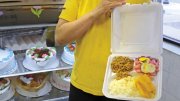Most New Englanders know East Boston only as the home of Logan Airport. But a recent tour of the wide range of Latin American restaurants and bakeries there proves that the community is a gastronomic destination on its own.
Food adventurers can walk or bike the streets and stop in for sweets like Mexican pastel tres leches (cake infused with sweet milk) or Peruvian-style alfajores (powdered cookies sandwiching dulce de leche), grab a savory Salvadorean pupusa (a thick corn tortilla stuffed with cheese or finely ground pork) to go, or settle down for a plate of Bolivian silpancho (potatoes or rice covered by schnitzel-style beef topped by a fried egg and cilantro or pico de gallo).
The affordable food is fresh and homemade, typically by the owners, their family members, or another local business.
“East Boston has the most diverse Hispanic population in the city,” says Merry “Corky” White ’63, Ph.D. ’80, a cook, food writer, and Boston University anthropology professor. That blending of cultures and chefs produces both “a mixing across ethnic foodways and a preservation of foods within each group,” she explains, “because everyone now lives in the same neighborhood and because all the older generation still want, and are making, their own dishes the way they always ate them.”
White teaches a course called “Boston: An Ethnographic Study” that gets undergraduates out of the classroom and into the city’s diverse communities to learn about politics, history, architecture, urban economics—and food. In East Boston, she starts the tour at the MBTA Blue Line’s Maverick Station, named, she says, for Samuel Maverick, who farmed the area in the 1630s with the help of slaves—“a fact that always surprises my students.”
Comprised of five islands linked by landfill over time, East Boston by the mid 1800s was an industrial and shipbuilding center and a main port for ships, such as Cunard Line vessels, that brought the first waves of Irish immigrants. (Joseph P. Kennedy was born there in 1888.) Italians, Russians, Poles, Jews, and others followed. Some of their descendents still live in East Boston, reports White, among both waterfront gentrifiers and the newer immigrants, who are primarily from El Salvador, Guatemala, the Dominican Republic, and Colombia. Italian landmarks—Santarpio’s, Jeveli’s, and Spinelli’s bakery—are still there, as are bars like Kelley’s Square Pub. “Barney’s Grill is left over from the Irish, then it was Italian,” White adds. “Now the TVs only play fútbol and they serve Corona” instead of Guinness.
White shops at the many family-owned markets for ingredients such as panela (brown-sugar loaves), fresh arepas (hefty corn-flour pancakes, good topped with fried cheese, meat, or jam), and jars of panca pepper paste. Following are some more of her favorite places to shop or eat.
La Sultana Bakery (www.lasultanabakery.com). Simple breads and frosting-heavy Colombian cakes of all colors, along with hot buffets that include the ubiquitous chicharrón (deep-fried chunks of pork and skins).
La Topacio (no website; 617-567-9523). Try the Salvadorean pupusas with pickled slaw, or the picado—chunks of chicken, beef, chicharrón, andsausage served over French fries, often in a sauce with peppers and onions.
Rincon Limeño (www.rinconlimeno.com). The Peruvian alfajores can be bought at the register, or dine in on shrimp ceviche, grilled steak with fried plantains, or the Colombian montañero (flank steak, fried pork rinds, and runny eggs over rice).
Lolly’s Bakery (www.lollysbakery.com). Dense, warm bread puddings (a Colombian favorite), Dominican cake dribbled with dulce de leche, rice pudding with a cinnamon kick, and yellow cake filled with flan.
Que Padre (www.facebook.com/QuePadreTaqueriaYMas). The Mexican and Bolivian specialties include silpancho and saltenas (pastry pockets filled with a juicy blend of chicken or beef, with potatoes, eggs, and peas).








